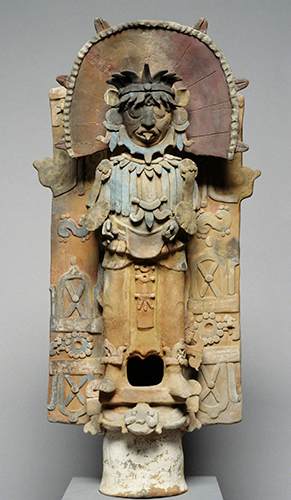Mayan Ceramics
I find it very interesting (in my geeky, art historian way) to contrast the art of cultures from all over the non-Western world and compare them to the “epitome” of aesthetics in the West, ancient Greece, and Rome. One of my favorite cultures to study is that of the Mayans of Central America. Not only did the Mayan civilization rival the Roman Empire for longevity and cultural influence, it was flourishing (ca. 250–600 CE) at a time when the Roman Empire was declining and Europe was entering the so-called Dark Ages (ca. 500–1000).
It is also interesting to contrast the art of two or more non-Western cultures. Just for fun, compare this Mayan work with ceramics or sculpture from, say, China, India, or Japan at the same time. I think it makes for a fascinating comparison.
 |
| Maya Culture, Incense Burner, from the region of Palenque, Mexico, 600–900 CE. Earthenware with pigments, 36 ¼" x 19" x 9 ¾" (92.1 x 48.3 x 24.8 cm). © Cleveland Museum of Art. (CM-471) |
The early Pre-Classic (ca. 1000 BCE–250 CE) Maya occupied Chiapas in Mexico, Honduras, and Guatemala until between 400 and 50 BCE when they began to spread to the Yucatan Peninsula. After centuries of egalitarian village living, they adapted a hierarchic, autocratic, city-state way of life. Although the reasons for the change are unknown, the platform pyramids, organization of cities, and the rule of warrior-priests represent the influence of Olmec culture and that of another early city-state culture in Teotihuacán.
Ceramic arts were practiced by Mesoamerican peoples from the time of the Olmec on. The most important objects were vases and jars meant to hold offerings in tombs, as well as incense burners, which were used during religious and burial ceremonies. Like most Pre-Columbian art, most objects come from grave sites. Large, sculpted clay figure ceramics such as this are typical of the Late Classic period (ca. 600–900 CE). Their emergence as a primary form of sculpture coincided with the cessation of the production of large scale, in-the-round stone sculpture, such as that at Copán. The use of pigments on ceramic objects was not a dominant element in Mayan work until after 600 CE.
This incense burner is a combination of molded sections and applied strips of decoration. Such objects were heavily used in Mayan society where all aspects of the society revolved around the religious rituals. Incense burners were often mass produced. As is the case with this one, the faces, limbs, and attributes were produced in molds and assembled. The figure represented in this piece is possibly that of the religious functionary known as a Chilam. The Chilam was a shaman-like person who interpreted and transmitted messages from the gods to priests. The messages that were transmitted determined what kind of human sacrifice would be done. Such unusual facial features were common in Mayan ceramics. The Maya delighted in depicting everyday, often crude, activities and gestures.
Palenque was not a major pottery center, but it was an important religious and political city-state during the Late Classic period. Like the other Maya cities of the Yucatan, Palenque was abandoned in the late 900s either during an invasion or because of a prolonged drought or other natural disaster.
On a side note, Curator’s Corner is included in the list of the 100 Best Curator and Museum Blogs. It is a pleasure examining the Davis Art Images archive every week and sharing it with the online community.


Comments